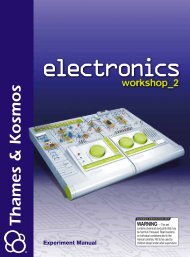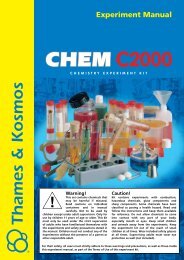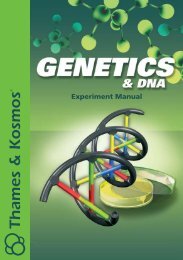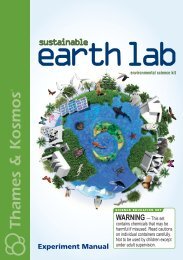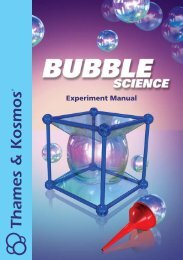Experiment Manual Sample Pages (PDF) - Thames & Kosmos
Experiment Manual Sample Pages (PDF) - Thames & Kosmos
Experiment Manual Sample Pages (PDF) - Thames & Kosmos
Create successful ePaper yourself
Turn your PDF publications into a flip-book with our unique Google optimized e-Paper software.
<strong>Experiment</strong> <strong>Manual</strong>
Kit Contents<br />
No.<br />
1<br />
2<br />
3<br />
4<br />
5<br />
6<br />
7<br />
8<br />
9<br />
10<br />
11<br />
12<br />
13<br />
14<br />
15<br />
16<br />
17<br />
18<br />
19<br />
20<br />
22<br />
23<br />
24<br />
4<br />
32<br />
Name<br />
25<br />
43<br />
44<br />
Anchor pin<br />
Joint pin<br />
Shaft plug<br />
Shaft pin<br />
Axle lock<br />
Washer<br />
Long frame<br />
Short frame<br />
Long rod<br />
Short rod<br />
Long axle<br />
Medium axle<br />
Short axle<br />
Medium pulley wheel<br />
Small pulley wheel<br />
Large gear wheel (60 teeth)<br />
Medium gear wheel (40 teeth)<br />
Small gear wheel (20 teeth)<br />
Base plate<br />
Crankshaft<br />
Connector bridge<br />
Turbine blade<br />
Rubber band (long)<br />
24<br />
7 46<br />
11<br />
16<br />
23<br />
17<br />
12<br />
8<br />
Qty.<br />
40<br />
12<br />
30<br />
2<br />
12<br />
12<br />
4<br />
6<br />
6<br />
6<br />
4<br />
5<br />
1<br />
4<br />
4<br />
2<br />
4<br />
7<br />
2<br />
2<br />
2<br />
16<br />
1<br />
4<br />
18<br />
13<br />
1 5 3 2<br />
30<br />
Part. No.<br />
702527<br />
702524<br />
702525<br />
702526<br />
702813<br />
703242<br />
703239<br />
703232<br />
703235<br />
703233<br />
703234<br />
703238<br />
703236<br />
702518<br />
702519<br />
702506<br />
702505<br />
702504<br />
703237<br />
702599<br />
703231<br />
702815<br />
703241<br />
40<br />
41<br />
42<br />
9<br />
10<br />
31<br />
22<br />
26<br />
No.<br />
25<br />
26<br />
27<br />
28<br />
29<br />
30<br />
31<br />
32<br />
33<br />
34<br />
35<br />
36<br />
37<br />
38<br />
39<br />
40<br />
41<br />
42<br />
43<br />
44<br />
45<br />
46<br />
20<br />
27<br />
Name<br />
6<br />
36<br />
35<br />
29<br />
19<br />
28<br />
Rubber band (medium)<br />
Cotton cord (white)<br />
Balloon<br />
Wheel<br />
Tire ring (medium pulley wheel)<br />
Anchor pin lever<br />
Crank<br />
Straw (red)<br />
Digging shovel<br />
Thermometer<br />
Measuring cup<br />
Plastic strip for clockwork motor<br />
Film for cutouts<br />
Boat hull<br />
Die-cut cardboard sheet<br />
Hydraulic pump<br />
Hydraulic switch<br />
Hydraulic cylinder<br />
Narrow tubing<br />
Thick tubing<br />
<strong>Experiment</strong> book<br />
XL (extra long) axle<br />
33<br />
14<br />
15<br />
39<br />
34<br />
Qty.<br />
1<br />
1<br />
1<br />
2<br />
2<br />
1<br />
2<br />
2<br />
1<br />
1<br />
1<br />
1<br />
1<br />
1<br />
1<br />
1<br />
1<br />
4<br />
1<br />
1<br />
1<br />
1<br />
38<br />
37<br />
Part. No.<br />
703374<br />
703244<br />
703531<br />
703230<br />
703251<br />
702590<br />
703377<br />
703513<br />
703514<br />
702280<br />
703532<br />
703240<br />
703380<br />
703519<br />
703522<br />
703515<br />
703516<br />
703378<br />
703500<br />
703511<br />
703510<br />
703518
12<br />
You will need these components:<br />
1 joint pin<br />
2 shaft plugs<br />
1 washer<br />
1 long rod<br />
1 rubber band<br />
1 cutout sheet<br />
2<br />
3<br />
6<br />
9<br />
24<br />
39<br />
Your force meter can measure the weight that pulls on the<br />
bottle. Thus, it functions as a scale.<br />
The densities of selected solid and<br />
liquid substances in kg/dm 3<br />
Fir tree wood 0.4 – 0.7<br />
Gasoline 0.75<br />
Water 1.0<br />
Nylon 1.1<br />
Sand (damp) 2.0<br />
Aluminum 2.7<br />
Iron 7.5<br />
Gold 19.3<br />
Densities of selected gaseous substances<br />
in kg/m 3<br />
Hydrogen 0.09<br />
Air 1.23<br />
Oxygen 1.4<br />
Nitrogen 1.25<br />
The weight of air<br />
Force Meter (0 to 2 N)<br />
The force meter measures forces<br />
between 0 and 2 N. Pull on the<br />
39<br />
9<br />
It is difficult to imagine that air weighs anything at all. But it can actually rip up trees<br />
when it is moved in a strong storm, so here is a demonstration that air does in fact<br />
have weight:<br />
4 Invisible Yet Weighty<br />
Weighing Air<br />
3<br />
3<br />
6<br />
washer and read the value on the<br />
scale. This will let you get a feel<br />
for the Newton unit of measure.<br />
You will need: 4 anchor pins 1 , 2 shaft plugs 3 , 1 axle lock 5 , 4 long rods 9 ,<br />
1 short rod 1 , 2 medium axles 12 , 1 base plate 19 , cord (20 cm) 26 , 1 balloon 27<br />
Assemble the scale. Wrap the end of the cord around the neck of the deflated balloon<br />
using a simple knot, but do not tie it tight yet. Tie the other end of the cord to<br />
the end of the scale arm (see picture). Establish a balance with a few counterweights<br />
(e.g. 1 axle, 1 shaft plug). Now fully inflate the balloon and pull the knot tight. The<br />
air is captured inside, and the scale arm with the balloon drops.<br />
2<br />
24
4. Gravity Helps Water Tip the Scales<br />
We will now be dealing with a property that air and water share with all bodies. They<br />
both obey the force of gravity and are attracted by the Earth. Of course, they do it in<br />
different ways. As explained above, a gas completely fills the container it is in, so it<br />
changes its volume correspondingly. It can be made “thicker” or “thinner.” Liquid water<br />
also adjusts to its surrounding container. But it retains its volume, filling only as<br />
much space as its volume requires. Because gravity pulls water straight down, water<br />
fills the container in such a way that it comes closest to the center of the Earth. In the<br />
process, its surface, or water level, forms a horizontal plane. That is the case even if it<br />
doesn’t have a continuous surface, as long as all parts of its volume are connected to<br />
one another.<br />
Let’s do an experiment:<br />
In interconnected containers such as coffee pots, teapots, or watering cans, the<br />
surface of the liquid is always at one level.<br />
Under the influence of gravity, the surface of a resting liquid always orients itself<br />
horizontally (at the same level). In communicating vessels (containers with different<br />
parts connected to each other), the surface of a liquid is always at one single level.<br />
5<br />
L1<br />
Everything on the Scale F1<br />
Water in Communicating Tubes<br />
You will need: 4 joint pins 2 , 1 large frame 7 , 3 small frames 8 , 1 base plate 19 ,<br />
1 measuring cup 35 , 1 section of the thicker tubing (about 60 cm) 35 , water<br />
Static Pressure<br />
Guide the tube<br />
L2<br />
through the holes of the framework. Loosen one end of the tube<br />
from its clamp and F2place<br />
it into a measuring cup filled with clean water. Using your<br />
mouth on the other end One-armed<br />
of the tube, suck water from the measuring cup until the<br />
Vertical stabilizer<br />
Wing<br />
water level in the tubing stands lever about halfway between the two horizontal frame<br />
sections. If you suck up too much water, blow some carefully back. Be sure that no<br />
air bubbles form in the tube — all the water must be connected without any interruptions.<br />
Clamp the loose end of the tube back into position, and watch the water<br />
Aileron<br />
level. Tilt the framework to the left or right and watch what happens.<br />
(wing flap)<br />
(vertical tailfin)<br />
F2<br />
You will see that on both sides of the tube, the water is at the same level, regardless<br />
of how the framework may be tilted. You will notice that the water has a cupped,<br />
concave surface, not a flat one, because it clings to the side walls of the tube. (You Pitch elevator (3)<br />
Rudder<br />
will learn more L2 about this in the next chapter.) The principle of communicating vessels<br />
is also used with the water level in F1<br />
L1 our next Workshop, which you can easily build<br />
yourself.<br />
Assemble the framework, and secure the tube with the<br />
Horizontal water to it stabilizer<br />
(1)<br />
(2)<br />
13
62<br />
Backhoe<br />
Most excavators work with a hydraulic mechanism. It comprises a motor pump<br />
(which produces the operating power) and hoses that transfer the power, along with<br />
operating cylinders that amplify the force.<br />
The backhoe driver controls the movement direction of the pistons and the<br />
movement of the shovel and shovel arm by way of control valves. The hydraulic fluid<br />
used is a special oil that coats the mechanism and only freezes at very low temperatures.<br />
In our model, the two rear cylinders work as a pump. The force for the pump<br />
is produced at the hand levers. They<br />
are also used to control the direction<br />
of movement of the pistons in the<br />
cylinders.<br />
> Read Chapter 10.<br />
A<br />
B<br />
C<br />
2<br />
8<br />
1<br />
1<br />
1<br />
8<br />
1<br />
2<br />
2<br />
1<br />
1<br />
D<br />
E<br />
2x<br />
10<br />
2<br />
8<br />
11<br />
You will need these components:<br />
8 anchor pins<br />
12 joint pins<br />
3 axle locks<br />
1 washer<br />
4 small frames<br />
2 long rods<br />
4 short rods<br />
2 long axles<br />
3 medium axles<br />
2 medium pulley wheels<br />
1 base plate<br />
2 wheels<br />
2 tires for medium<br />
pulley wheels<br />
1 XL (extra long) axle<br />
1 backhoe shovel<br />
4 hydraulic cylinders<br />
4 sections of narrow tubing<br />
1<br />
1<br />
2<br />
10<br />
1<br />
2<br />
5<br />
6<br />
8<br />
9<br />
10<br />
11<br />
12<br />
14<br />
19<br />
28<br />
29<br />
46<br />
33<br />
42<br />
43
F I<br />
G<br />
H<br />
10<br />
42<br />
43<br />
2<br />
2<br />
2x<br />
2<br />
42<br />
Be sure that there is only water and no air in the two<br />
hydraulic cylinders and in the tubes. See pages 9 and<br />
10 for how to remove air from cylinders and tubing.<br />
33<br />
K<br />
J<br />
8<br />
2<br />
63



